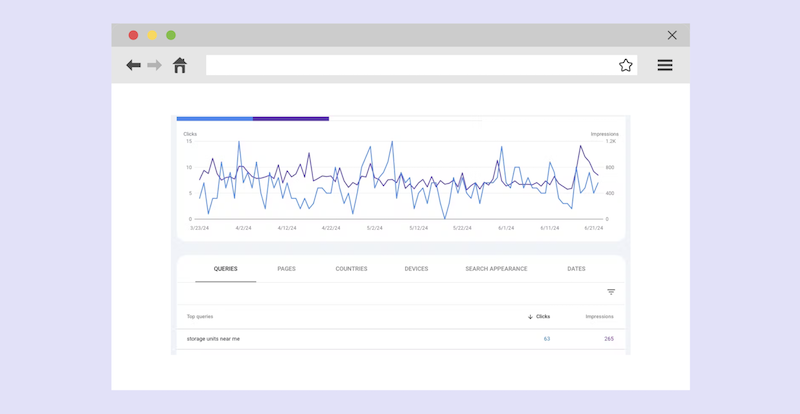
20 Aug 2024
Impressions. CTR. Conversions. Page views. Ranking.
There are so many metrics that get thrown around for websites. Do you know what they all mean?
More importantly, do you know which ones matter? Or how to read them in a way that can help your digital marketing efforts? What do they really say about your self storage SEO?
While all of these metrics have their own value, they’re virtually meaningless without context and without understanding their relationships with each other.
Let’s take a crash course on website metrics to help you understand how your self storage website is performing!
Before we dive into how to understand them, some of you might need to know where to look first.
The rentals are easy to track. But what about impressions, clicks, and other numbers?
For some storage operators, your website provider may report on these for you already. They may come in the form of a monthly or quarterly report, or maybe you have access to them in real-time. For example, facilities using StoragePug websites can view many of these metrics in their Insights dashboard.
For others—or if you want a more detailed look—you can open up Google Search Console.

If you need help setting up Search Console, you can read Google’s own guide.
Once set up and logged in, click on “Performance” to view impressions and clicks! You can sort these metrics by query, page, and other categories that are a bit less useful for most operators (such as country or device).
Pull up the data from your self storage website or receive a report from a marketing company, and you’ll receive all sorts of numbers from different metrics.
Organic ranking, local ranking, impressions, CTR, clicks, and so on.
Let’s go over the most common ones and talk about what they actually mean.
Rank. Ok, this one should be obvious, right? For most of these metrics, higher means better. For ranking, though, we want a lower number. There are two different kinds of ranking we’re really concerned about for your website: Organic and local. SEO best practices focus on giving you the best rank for both, though each is improved in slightly different ways.
Impressions. This refers to how many people see your page on Google search.
Clicks. Can you guess what this one is? Yeah, it’s how many people click on your page in the search results page.
CTR. This stands for Click-Through Rate and is expressed as a percentage. Basically, the percentage of impressions that turn into clicks.
Conversions. This can mean many things. It depends on your goal. For self storage, the best conversion rate to track is rentals.
Wouldn’t you like to know?
Just kidding. The fact is, this is mostly a trick question.
They all matter. Different measures can tell you different things, but they all work together to tell how your website is doing.
If your facility is near-capacity, then even your number of rentals only matters so far as it means you’re not losing occupancy quarter-to-quarter, for example. Everything requires context to understand and judge.
Some people think every number tells a story. I think they’re wrong: every number tells a part of the story, and what that story is depends on the relationships between those parts.

Let’s start by talking about what most people fixate on: Rank.
This is what most people obsess over. Marketing companies base their entire sales pitch on improving it.
Well, there’s more to your website’s performance than rank. And anyone who promises they can get you the top spot quickly is over-promising at best. Improving your rank in most markets takes time, research, and trial and error.
However, this doesn’t mean rank doesn’t matter at all. We know that impressions are how many people see your website in search. Well, the higher your rank, the more impressions you have a chance at earning in your market.
The relationship between rank and impressions is close to parallel. Rank improves, and impressions go up.
More impressions will usually mean more clicks, though it isn’t always the case. More clicks also doesn’t mean a higher CTR—you can have more impressions, more clicks, but the same (or even lower) CTR.
Let’s look at a very simplified example:
You’re rank 2, and you get 1,000 impressions. Out of those impressions, you get 100 clicks. That’s a 10% CTR.
After some hard work, you go up to rank 1. Congratulations! Now you get 2,000 total impressions. You also get 200 clicks. Awesome! That’s a 10% CTR.
Notice that your click-through rate didn’t improve. You did get more clicks, though!
It’s also possible to go up to rank 1, get 2,000 impressions, and get only 150 clicks. Or even 110. In both of these cases, your CTR actually declined (even though your clicks still improved).
Alright. Here’s where we get into the good stuff.
You’ve improved your rank. You get more impressions. You get more clicks. Are you getting more rentals?
In an ideal world, yes! But not always.
Also, it’s possible to keep your rank exactly the same and improve your clicks (which also means improving your CTR) and your rentals (or your conversion rate).
If you’re getting 100 people to your website, and 5 are renting, that’s a 5% conversion rate. But you can also tweak your website to improve conversions, meaning those same 100 clicks get you more rentals.
Or, you can stay at rank 2, still get 1,000 impressions, but make tweaks to your page title and meta description (the title and description that show up in search) and get MORE clicks! Maybe you even double your clicks, getting 200 (20% CTR), 5% of which convert, turning into 10 rentals instead of 5!
Phew. That’s a lot to follow.
I’d love to boil these metrics down to a fun analogy for you—something about popcorn and popcorn buckets at movie theaters—but the truth is that the relationship is more complicated than that.
Instead, let’s just try to say that all again a bit more simply:
Get self storage specific advice and strategy with StoragePug's Ultimate Guide to Self Storage SEO!
Alright. The relationship matters. Now, how do we look at that relationship?
I’ll pitch some general concepts first. Then, we can go into some specific scenarios to help better understand.
Getting a higher rank means a higher share of the impressions for the query. But a dip in your impressions doesn’t always mean your rank declined, and you can also see more impressions without improving rank.
In the same way, fewer rentals don’t always mean that your website conversion rate is down. Without looking at the clicks, you can’t tell if the conversion rate has changed at all. And without looking at impressions, you’re not sure if fewer clicks mean a worse CTR or fewer impressions. And without checking your rank, you aren’t sure if you’re getting fewer impressions due to an SEO problem or a market condition.
Next up are some examples of scenarios you might encounter and how you can dive into the data to make sense of what you’re seeing.
When rentals start to go down, one of the first places operators look is the website. Are online rentals down?
If so, the next thing you probably do is evaluate your search performance.
But if your rank is roughly the same (a few places won’t make a very large difference in most cases), what’s next?
Check your impressions.
Conclusion: If your rank is roughly the same, but your impressions are significantly down, this means fewer people are searching for storage. It’s a matter of the market conditions
If your rentals have declined and other important metrics have remained roughly the same, this MAY mean you have something impacting your website conversions.
It is a little bit unusual for your website conversion rate to drop suddenly without you having made any changes. This is the first place to start: Did you change your online rental process? Did you change the landing page where people first arrive from Google search most often? Is there some kind of error with your rental flow?
Conclusion: This is a conversion issue. Check your prices versus competitors. See if there are any pain points in your rental process that may be causing people to drop off. With some web providers, you may be able to see exactly where people are dropping off the train.
Once your rentals drop and you check your numbers, are you seeing your rank and impressions stay steady?
What about your clicks?
If your rank is stable, it isn’t a visibility change. If your impressions are stable, it isn’t a market change (probably). If your clicks are low, though, it’s an issue with attracting searchers to your website.
This can happen for a number of reasons. One key potential reason is that your competitors have adjusted their page titles and meta descriptions to be more attractive than yours.
Another reason is that if there were no (or few) ads before, competitors may have started running more Google Ads. This can lead to a drop in clicks because it funnels more of the clicks to ads without dropping the rank or impressions of the top results.
Conclusion: This is an issue with your CTR, which could mean two things: You need to adjust your page title/meta description, or you need to check if competitors are running Google Ads when they weren’t previously. If they are, and your lost rentals are too important to weather, you may need to consider ads yourself.
If you don’t understand your website’s metrics, they’re useless to you.
It’s easy to just look at a drop in rentals and blame your website’s SEO or performance. But sometimes that’s not where the smoke trail is actually coming from.
Spending time and effort fixing a problem that doesn’t exist is a waste.
By understanding your self storage website’s metrics, the relationship between them, and how to read changes in the numbers over time, you can get a better grasp on your website’s performance and how it’s serving your business—and what to do when you see a dip in online rentals!
This article was originally posted on the StoagePug blog on July 9th 2024, by Robert Priester
Robert Priester is the Senior Content Writer for StoragePug in Knoxville, TN, where he writes content for self storage websites, informative blog posts about marketing or storage, and ebooks that educate the industry. He has been with StoragePug since 2021. Robert's goal is to help smaller operators understand storage and marketing in new ways and refine the way they do business in order to succeed.